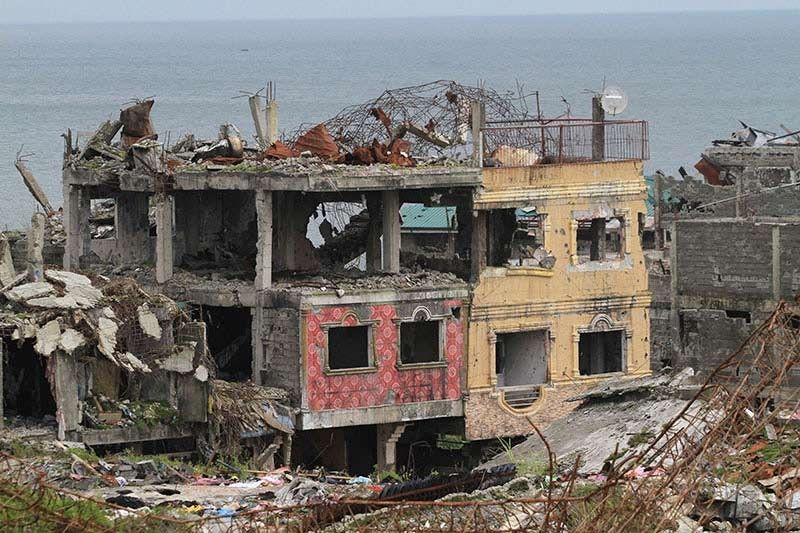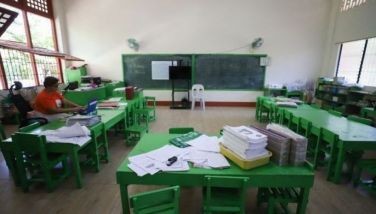Bangon Marawi says clearing over by November's end

MANILA, Philippines — Two years after the former Islamic center of Marawi was declared liberated from terrorist presence, the task force in charge of the city's rehabilitation said they were down "about 17 or 18 [unexploded] bombs" which they hoped to clear by the end of October.
Task Force Bangon Marawi (TFBM) on Thursday held a media briefing to mark the second anniversary of the end of the Marawi City siege. They vowed the clearing of the city debris would be over by November 30.
Demolished structures
Representing the 56 government agencies that compose the task force, TFBM Chairman Eduardo del Rosario said there were still buildings that had to be cleared, at which point they would undergo ground penetrating radar scanning and other general sweep of the area.
The chairman said they were still targetting around 4,000 buildings for clearing with over 2,800 consenting house owners. Of this amount, at least 2,400 houses were already demolished leaving some 400 remaining.
He said they were still "looking into resolutions" with more than 1,000 remaining residents who have not given consent.
"There is a possibility that there may be bombs in those buildings, but since [unconsenting residents] do not [want] them to be touched, we have to discuss and find out the safety considerations in those 800-1000 units."
Asked about the possible plans for road expansion, Del Rosario said that during the consultations conducted by the task force "[m]ost, maybe more than 90% of the residents agreed that they are willing and they support the expansion." He said that the Marawi LGU had been engaging with "256 residents" about buildings that would get affected by the road expansion.
"Anyway, the government will pay them [...] depending on the market value of the existing lot[s]," he added. "We do not [want] to expropriate anymore because it will entail so much process."
Marawi City Mayor Majul Gandamra on Wednesday also admitted to green-lighting the demolition of public structures within the city despite not having some residents’ full consent. He claimed it was “a judgment call” necessary to expedite the already-delayed rehabilitation process.
In response, the Moro Consensus Group on their Facebook page urged the city’s government to stop the illegal demolition of private buildings owned by unconsenting residents.
Financial assistance and funding
Del Rosario drew a distinction among affected residents into two groups: those capable of reconstructing their respective buildings, whom he said largely resided in the most affected area and could shoulder their own costs, and those unable to carry the cost of the damages and who would have to "wait for the approval of the compensation bill."
He was referring to House Bill (HB) No. 3543 or the Marawi Siege Victims Compensation Act, which he said was "moving forward" in the Lower House. If passed into law, the bill will grant P1,500 worth of compensation per square meter of any places of residence destroyed during the siege.
That bill, he said, would serve as the financial assistance for the latter group.
He also clarified that some pledges, grants and soft loans, especially those from international and development partners, weren't necessarily given to government.
"Pledge pa lang iyan: we are hearing so much [about] billions, pero salita pa lang, but in reality, maaaring hindi pa naibibigay kahit kaninong agency," he said.
Del Rosario explained that some partners, like the US aid, gave the funds to their own agencies for implementation instead of the Philippine government. "Yung ganoong commitment, mayroon silang UN or NGO partners, at iyon ang magi-implement."
Of the grants given by international governments directly to the national government, Del Rosario insisted that there was "[nothing to] worry about" as the Commission on Audit was handling the transactions.
The international community has donated over P37 million collectively to rehabilitation efforts. However, the city's evacuees claim that this sum has remained largely unused.
Internally displaced persons
Del Rosario said it was "very clear" that DTI was not receiving any foreign grants, and instead received funds only from the national government.
Linda Boniao, DTI-Northern Mindanao director clarified that the department provided assistance to some 26,000 beneficiaries in Marawi where 38 projects are taking place today.
"Today, our distribution runs almost everyday. Some Maranaos already have noticed that traffic is being caused by our distribution of rice," she said in Filipino.
The Internal Displacement Monitoring Centre's 2019 Global Report on Internal Displacement shows that as of March 2019, around 73,000 people belong to some 2,000 families are still displaced and living in the 21 government-run evacuation centers, while others settle for staying in transitional shelters and the homes of relatives.
Sanitation and waste management issues are rampant in these government centers. In 2017, the Department of Health announced that 86 evacuees passed away in evacuation sites due to poor conditions.
Debris clearing and road expansion are just two of the first five components of the city's rehabilitation as the task force has outlined a total of 22 components for Marawi's recovery, parcelled off to different private bodies. The city’s overall rehabilitation today hinges largely on the administrations 892 projects all slated to be completed by 2022.
- Latest
- Trending





























